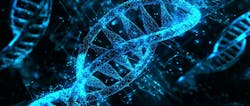Scientists create tool to detect genes associated with brain disorders
Scientists at the UNC School of Medicine and colleagues created a new computational tool called H-MAGMA to study the genetic underpinnings of nine brain disorders, including the identification of new genes associated with each disorder.
The research, published in Nature Neuroscience, revealed that genes associated with psychiatric disorders are typically expressed early in life, highlighting the likelihood of this early period of life as critical in the development of psychiatric illnesses. The researchers also discovered that neurodegenerative disorder-associated genes are expressed later in life. Lastly, the scientists linked these disorder-associated genes to specific brain cell types.
"By using H-MAGMA, we were able to link non-coding variants to their target genes, a challenge that had previously limited scientists' ability to derive biologically meaningful hypotheses from genome-wide association studies of brain disorders," said study senior author Hyejung Won, PhD, assistant professor of genetics at the UNC School of Medicine and member of the UNC Neuroscience Center. "Additionally, we uncovered important biology underlying the genetics of brain disorders, and we think these molecular mechanisms could serve as potential targets for treatment."
Brain disorders such as schizophrenia and Alzheimer's disease are among the most burdensome disorders worldwide. But there are few treatment options, largely due to our limited understanding of their genetics and neurobiological mechanisms. Genome-wide association studies (GWAS) have revolutionized our understanding of the genetic architecture related to many health conditions, including brain-related disorders. GWAS is a technique that allows researchers to compare genetic sequences of individuals with a particular trait—such as a disorder—to control subjects. Researchers do this by analyzing the genetic sequences of thousands of people.
"To date, we know of hundreds of genomic regions associated with a person's risk of developing a disorder," Won said. "However, understanding how those genetic variants impact health remained a challenge because most of the variants are in regions of the genome that do not make proteins. They are called non-coding genetic variants. Thus, their specific roles have not been clearly defined."
Prior research suggested that while non-coding variants might not directly encode proteins, they can interact with and regulate gene expression. That is, these variants help regulate how genes create proteins, even though these variants do not directly lead to—or code for—the creation of proteins.
Won and colleagues used this map to identify genes and biological principles underlying nine different brain disorders, including psychiatric conditions such as schizophrenia, autism, depression, and bipolar disorder; and neurodegenerative disorders such as Alzheimer's, Parkinson's, amyotrophic lateral sclerosis (ALS), and multiple sclerosis (MS).
Using the computational tool H-MAGMA, Won and colleagues could link non-coding variants to their interacting genes—the genes already implicated in previous GWAS findings.
Another important question in brain disorders is to identify cellular etiology—the cells involved in the root cause of disease. This is especially critical as the brain is a complex organ with many different cell types that may act differently in response to treatment. In the attempt of finding critical cell types for each brain disorder, the researchers found that genes associated with psychiatric disorders are highly expressed in glutamatergic neurons, whereas genes associated with neurodegenerative disorders are highly expressed in glia, further demonstrating how the two disorder clusters diverge from each other.
H-MAGMA is publicly available so that the tool can be widely applicable and available to the genetics and neuroscience community to help expand research, with the goal of helping people who suffer with brain-related conditions.





